Nintendo Switch review: An ambitious console that's missing pieces
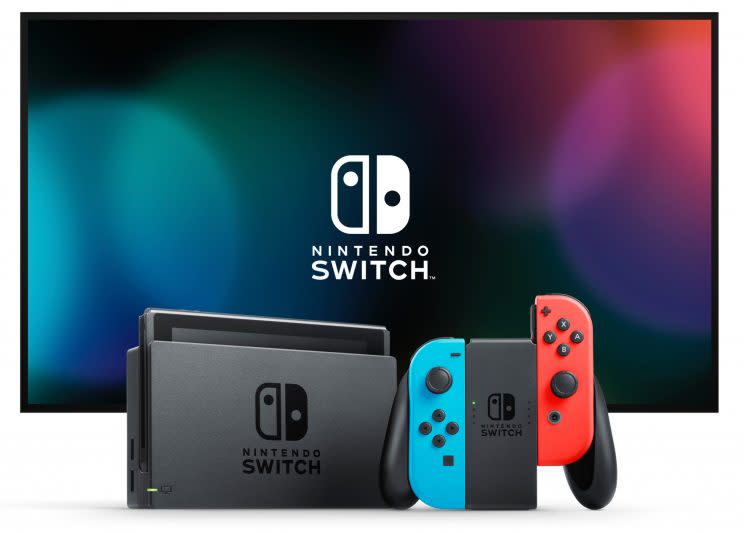
Update: This piece has been updated to reflect changes to the system due to Nintendo’s Day One patch.
Releasing worldwide March 3, the Nintendo Switch ($300) is more than just a new video game console: It’s a day of reckoning — or a moment of clarity — for arguably the most important company in the history of video games.
The purveyor of legendary franchises and systems struck out with their last home console, the Wii U. An unmitigated disaster, the Wii U simply couldn’t compete with more powerful systems from Sony and Microsoft, and failed to find a home with gamers looking to move past the quirky wand waving of the original Wii. Turns out a tablet you can’t travel with built for a system lacking the biggest games wasn’t a great idea.
The Wii U was more than that, of course. Those of us who took the plunge found bits and pieces of the same magic Nintendo poured into other systems — solid takes on “Mario Kart,” “Super Mario,” “Smash Brothers” and the fresh franchise “Splatoon,” mostly — but the ingenuity, the risk-taking bravado that yielded games like “Wii Sports,” “Metroid” and “Super Mario 64” and systems like the Wii, was M.I.A.
To make up for it, Nintendo has been busy monetizing the hell out of itself. It had last holiday’s biggest toy with the nostalgia-packed NES Classic Edition, shook the mobile world to its core with “Pokemon Go,” and made millions with “Super Mario Run.” But with the Wii U gasping and the handheld 3DS line stagnating, we have all wondered what, exactly, would become of Nintendo the console maker.
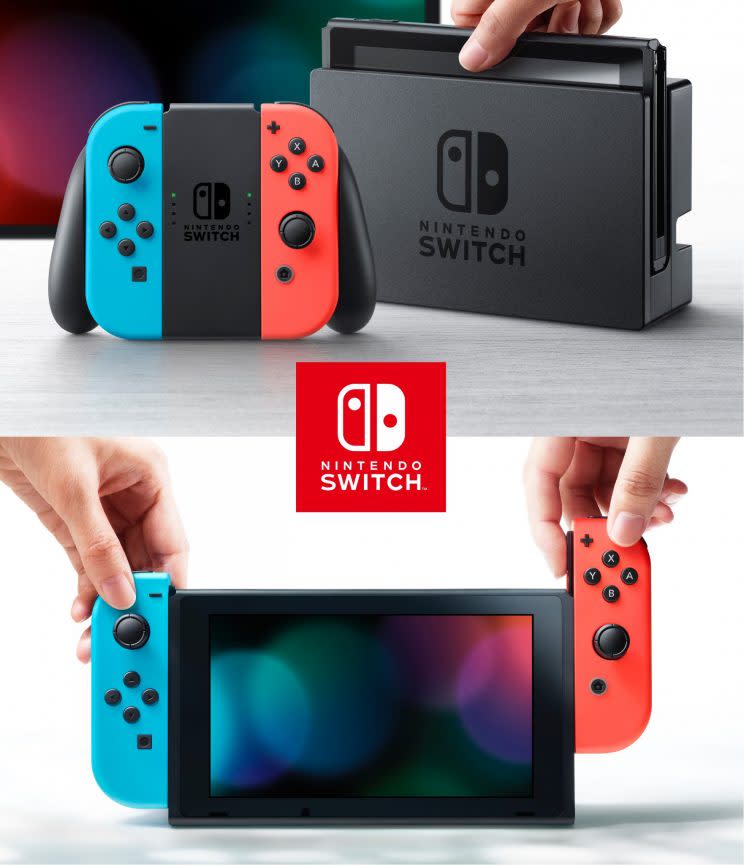
The answer is the Switch. Aiming to unite the company’s disparate audiences by pulling double duty as an all-in-one home console/portable machine, the Switch is an interesting proposition. It’s a solution in search of a problem — most gamers function just fine with a console tethered to their entertainment center and a smart something-or-other to entertain them on the go — but Nintendo excels at giving people great things they didn’t realize they totally needed.
Does that describe the Switch? That depends on how much you love the “Legend of Zelda,” because other than one extremely awesome launch game, this smartly designed console isn’t quite ready for prime time.
High-tech tech
Technologically speaking, the Switch is Nintendo growing up.
The console itself is a 6.2-inch touchscreen tablet that can connect to a living room TV or be taken on the go like a traditional handheld device. It’s a solid hunk of tech, with harder angles and more heft than the Wii U tablet. It’s on par with the kind of consumer tech you’d expect from Samsung or Apple, and a far cry from the kid-first feel of the Gamecube and Wii.
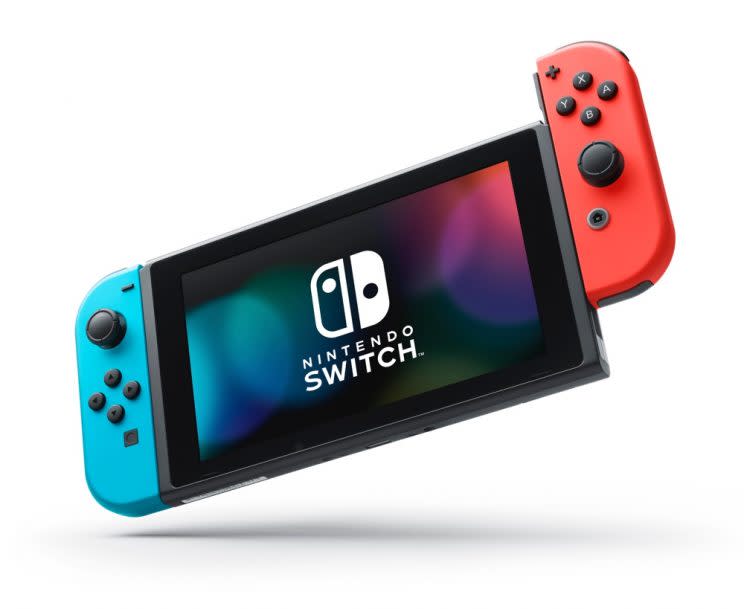
The tablet rests in a small innocuous dock that connects it via HDMI to your TV and via AC adapter to power. Pull the Switch out of the dock and the onscreen image quickly shifts back to the tablet’s screen, ready for your backpack (or the official Switch carrying case … sold separately, naturally.)
The box also comes with two “Joy-Con” controllers, which can be used in various ways to interact with the Switch. Each Joy-Con has a joystick and a few face buttons. One has a “home” button, while the other has a terrifically useful “screenshot” button to instantly grab a shot of whatever’s happening on screen.
Holding one in each hand works fine, though you can also slip them into the included Joy-Con Grip to give them a more stable, classic gamepad feel. The Joy-Cons work when separated, too. Connect the included wrist strap and each Joy-Con becomes a mini-controller tailored for Wii-like party-based games. Alternately, you can slide the Joy-Cons into the tablet itself, effectively making it a giant Game Boy.
The result is occasionally fiddly but mostly brilliant. Slipping the Joy-Cons into the tablet yields a satisfying ‘snap’, and the system recognizes every other controller configuration remarkably quickly. The Joy-Cons are dripping with tech — accelerometers, infrared motion detection, gyro sensors, advanced “rumble” feedback — and while they’re a bit on the small side, jamming them into the Grip works in a pinch for bigger hands.
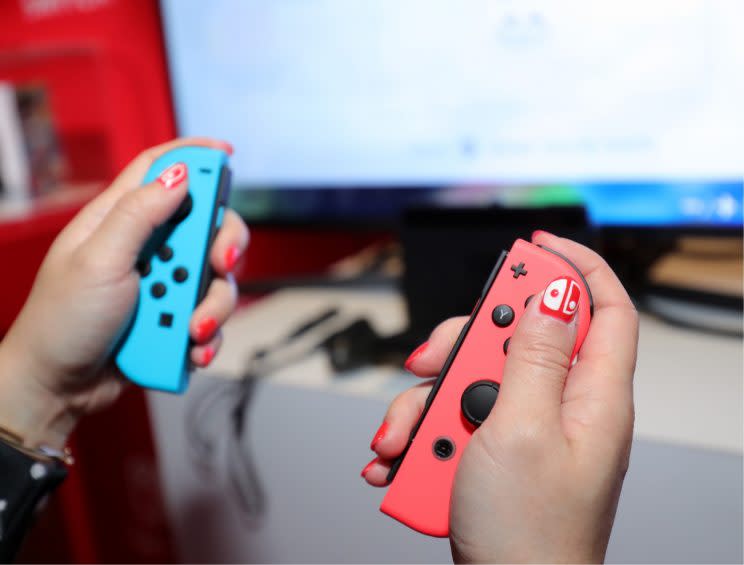
Better still, the Switch’s conceptual premise works wonderfully out in the wild. I traveled for a few days with my Switch and it felt like an extremely fancy handheld; I returned home, popped it back into the dock, and it felt like a console. There’s really no difference in the experience; if anything, games look a bit sharper and tend to run a bit smoother in tablet mode.
The device’s multi-functional, grab-and-go approach could have fallen on its face, but Nintendo went all out to make the Switch feel like a mature, confident piece of tech. It’s truly the switch-hitter it set out to be.
Power down
It’s not a home run, however.
For a system Nintendo hopes players will take on the road, the Switch doesn’t hold a very long battery charge. This varies from game to game, but in testing “The Legend of Zelda: Breath of the Wild” (the game every Switch owner will be playing for the next three months), Nintendo’s previously revealed three-hour battery life statement holds true. That’s pretty meager for a handheld device.
The Joy-Cons require their own charge; re-attaching them to the tablet while it’s charging will do the trick, though Nintendo overlooked a pretty common use case by failing to include a way to charge the controllers and continue playing while the tablet is docked. You can connect them to the included Grip, but that’s just a formed piece of plastic and cannot connect to any power source.
The solution? You’ve got a few. The cheapest is to just remove the tablet from the dock, connect the Joy-Cons to the tablet, connect the tablet to a power source and play with the system as a portable until they’re charged. Alternately, you can buy another accessory, the Joy-Con Charging Grip ($30), which is identical to the standard Grip except for a small USB-C port included on the top.

Your best bet may be to buy yet another accessory, the pricey Switch Pro Controller ($70). It’s expensive, but is a much better gamepad for action games like “Zelda” (the one game you will be playing, remember) and can be plugged right into the dock for charging while playing.
These are the sorts of problems most consoles don’t worry about, but I guess if you insist on delivering a million ways to interact with a console, it’s bound to get fussy. And while annoying, none of these are deal breakers, especially when compared to the Switch’s sync issue.
Sync or swim
Sadly, at the time of writing there is very clearly a hardware issue affecting the way the Switch recognizes the Joy-Cons.
All is well when you play the system as a handheld. But when playing with detached Joy-Cons, I occasionally experienced a noticeable interruption in the Joy-Con’s responsiveness. This was primarily with the left Joy-Con (the one most games use for movement), and seems tied to physically obstructing the wireless connection. Simply crossing my legs while playing and holding the left Joy-Con below my knee resulted in some connection errors – and a few untimely deaths in “Zelda.”
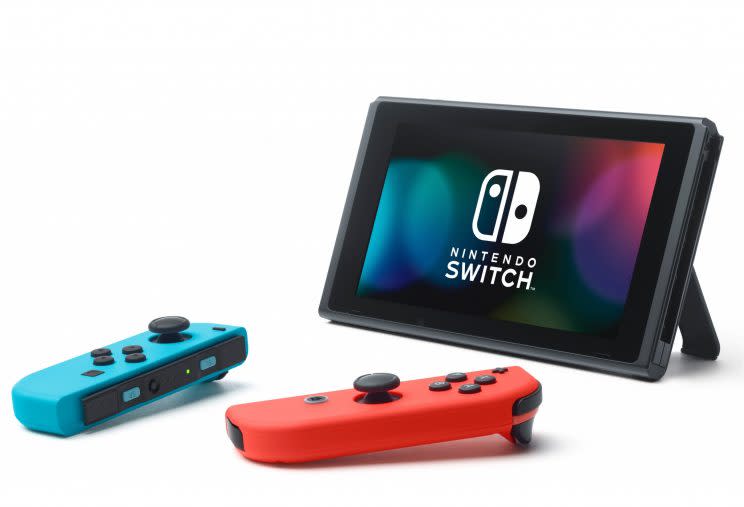
Reports from many other outlets confirm this isn’t just about my particular review unit. Even after Nintendo’s launch patch the syncing issues persisted. It remains unclear if this can be solved through a simple firmware upgrade or if it will require something more elaborate, like a hardware recall. For Nintendo’s sake, I certainly hope it doesn’t.
Game drain
The same can be said for the Switch’s woefully anemic launch lineup.
Console launch lineups are typically pretty bad, often a hodgepodge of old and new risk-averse games. But only 10 are available for the Switch on launch day. That is ridiculously paltry. The Wii U had 23 launch titles. The PlayStation VR had 30. The Xbox One totaled 22, there were 25 for the PS4, and 21 for the Wii (not counting the 12 classic games that came with the launch day Virtual Console).
Worse, only one of those games is really worth the price of admission. The thing is, “The Legend of Zelda: Breath of the Wild” is such an outrageously good game, it almost makes up for the other nine. I’m not reviewing “Zelda” here (our review posts on March 2) but suffice to say it is the biggest, boldest “Zelda” ever, a game-changer for the venerable series, and one that joins “Tetris,” “Super Mario Bros.,” “Super Mario 64,”and “Halo” in the launch game all-time top 5.

The rest of the lineup, however, is an all-time stinker. “1-2 Switch,” Nintendo’s minigame callback to the system-selling “Wii Sports,” is a shockingly low-rent and wildly overpriced ($50) collection of 30 mindless tech demos. It tries way too hard to turn the Switch into a party system, constantly urging you to look at the other player instead of the screen. During the lousy ping-pong minigame, a disembodied narrator instructed me to “imagine a table, and a ball” as I pretended to play ping-pong. Considering the state of gaming in 2017, asking gamers to “imagine graphics” is not, as the kids say, lit. Or as people my age say, cool.
It gets less interesting as you peruse the list. Obligatory Switch versions of previously released games like “Just Dance 2017” and “Skylanders: Imaginators” aren’t very exciting, and while I appreciate the terrific indie “Shovel Knight,” it dates back to 2014. “Super Bomberman R” is just more “Bomberman.” Even the best of the rest, the charming puzzler “Snipperclips,” is pretty lightweight.
So, it’s “Zelda” or bust. For millions, that will be just fine; “Breath of the Wild” is big and deep enough to warrant many months of play and exploration. And of course there are more coming. Nintendo expects 60 indie games to hit the Switch this year alongside a few big first-party games like “Splatoon 2,” the boxing game “Arms,” and surefire holiday hit “Super Mario Odyssey.”

But considering the slow rollout of software for the Wii U and Nintendo’s long-standing problem of getting third-parties on board with its consoles, a crummy launch lineup isn’t helping redefine the company as a major hardware player.
Space saver
The good news is that the OS powering the Switch is pleasantly streamlined and minimalist. Retail games, which come on tiny cartridges dwarfed by even a 3DS cart, load astonishingly quickly. Navigating menus is a breeze, and there’s no crazy, confusing Wii Plaza or anything to jumble up the screen.
Problematically, the system only ships with 32 GB of memory. Though retail games won’t take up any space at all (on other consoles they eat up install space), downloadable games will gobble that up quickly. A digital version of “Zelda” alone will take up about 13 GB.
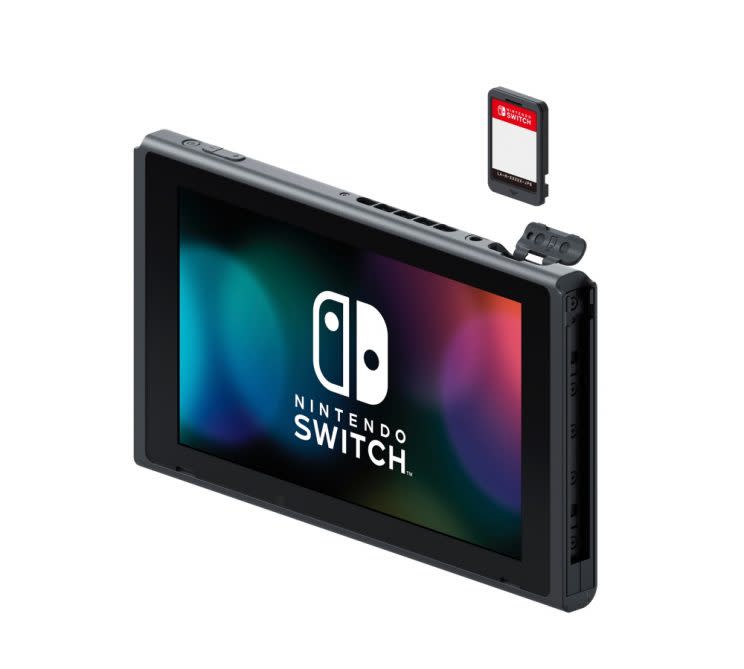
The memory can be expanded with micro SDXC or SDHC cards, and while the price of those is a bit steep currently (a 256 GB card will set you back $150 or so), there is at least an upgrade path here. If you’re planning to download a lot of games — and considering that digital downloads are only growing in popularity compared to traditional retail boxes, you probably are — expect to pay extra.
Feature story
But for all we know about the Switch, there remains a deep well of questions. Nintendo’s Day One patch includes the ability to access the digital eShop and add Friends.
Like the rest of the UI, the eShop is fast and straightforward, offering the small list of launch games alongside a “coming soon” section promoting a handful of future releases. You’ll need to create a brand new Nintendo Account, but can link that up to your old Nintendo Network ID to access whatever funds you happen to still have in your wallet.
Making friends, however, is less snappy. The dreaded 12-digit Friend Code system Nintendo introduced with the Wii makes an unwelcome return. You’re assigned a random Friend Code the moment you create your account, and if you want to be friends with another Switch owner, you’ll have to pass this ridiculous, hard-to-memorize number their way. In a smart break from the past, however, only one code is needed for two players to become friends. Send your code to someone and you’ll never have to input theirs.
There are a few other ways to connect. Linking to the same Nintendo Account you used for the mobile games “Miitomo” and “Super Mario Run” will drag over any friends you might have made there. You can also make friends with nearby players wirelessly, send requests to people you played with recently and, according to Nintendo, will eventually be able to pester pals on other social networks. Mostly, though, you’re using Friend Codes, and they’re still wonky and stupid.
The Switch, though, is still lacking a number of key features at launch. The Virtual Console, Nintendo’s gateway to loads of classic games from their vast library, will not launch alongside the system. If you still have funds in the digital wallets of your 3DS or Wii U, you’ll be able to access that money to use with the Switch, provided you link up your accounts. But Nintendo still won’t say if you’ll gain access to your old Virtual Console purchases. Considering that the VC stretches back to the Wii, being asked to re-purchase old games you have possibly purchased a few times already isn’t particularly consumer-friendly.
Also notable is the lack of any non-gaming apps at launch. No Netflix, no Spotify, nothing beyond games. For some this will be a breath of fresh air — we don’t need every streaming service on every device, do we? — but considering the console’s portability, its potential to replace, say, an iPad on a work trip is mitigated.
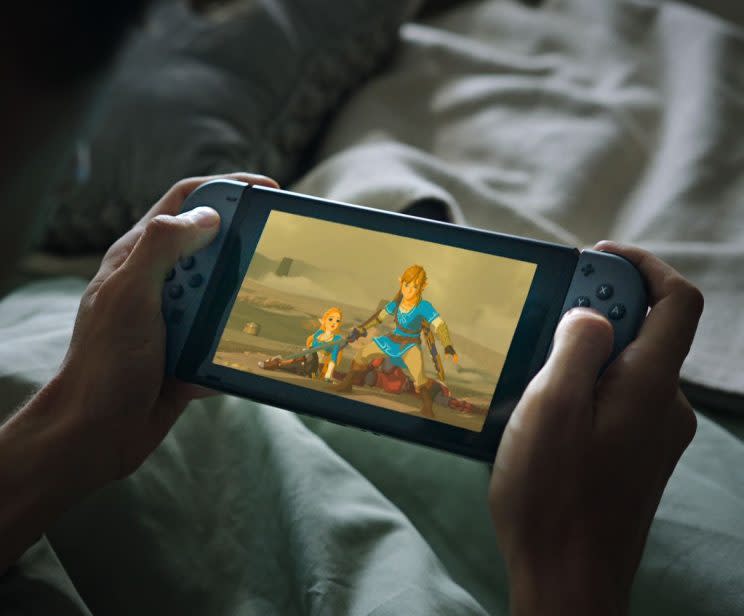
More concerning is the lack of a comprehensive online gaming network. The system is online — you can indeed play against other gamers in the few games that support it, like the racer “Fast RMX” — but it’s essentially in beta. Nintendo is planning to roll out an Xbox Live/ PSN-like service this fall, but has yet to deliver any details regarding price, features or caveats. There is currently no achievement system, no way to share video clips, no way to chat and no way to gather together in a party and explore games together. The system seems to have trouble recognizing if other friends are even online. It just feels rushed and incomplete.
Nintendo has never been great with online play, but to zone out on such a core console ingredient seems at best foolish and at worst tragic. Switch owners might not be built of the same stuff as competitive “Call of Duty” players, but the basic ability to play games or interact with friends online has been part of the console experience for many years now. Nintendo had an opportunity to grab this particular bull by the horns and redefine our expectations; instead, we’re all left wondering what the future holds.
The verdict
So what does it hold? Where will the Switch be in three years? And more crucially, should you buy in on Day One (or whenever units become available again)?
I want to say yes. I desperately want people to experience “Zelda,” a shoo-in for Game of Year contention. It’s that good, and it serves as a reminder that when it comes to building killer video games, Nintendo is still among the best in the business.
But when it comes to building a polished console ecosystem, they’re lost in Gerudo Valley. As great as “Zelda” is, it’s not worth $360 (plus it’s releasing on the Wii U, which you might already own). With few other games worth your attention, tons of missing features and a potentially problematic hardware glitch, the Switch doesn’t make a great first impression.
I have faith that Nintendo will solve some of this stuff, and that we’ll see a number of great games down the line. The Switch’s hybrid functionality is genuinely cool, and the core tech is some of the best Nintendo has ever built. But until we really see the software flow and the network flourish, it remains a system making big promises that it might not keep. We’ve seen Nintendo play this game before. Here’s hoping they quickly learn how to win it again.
More games news:

